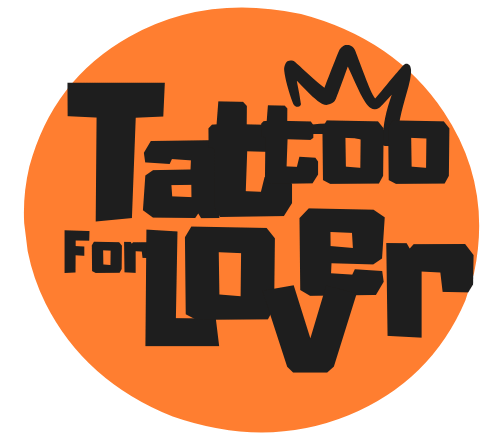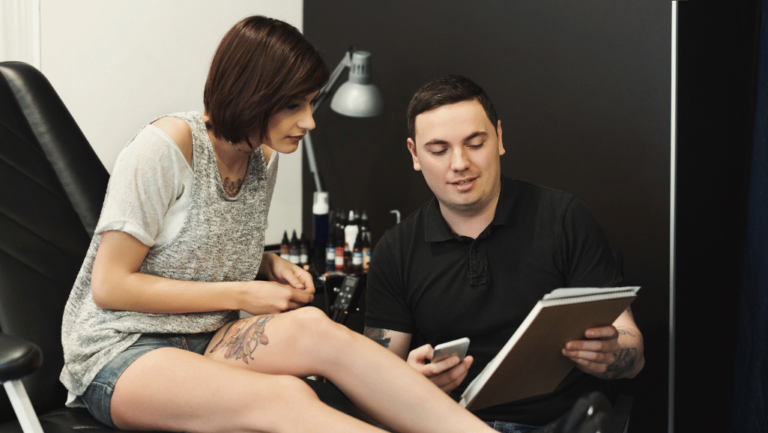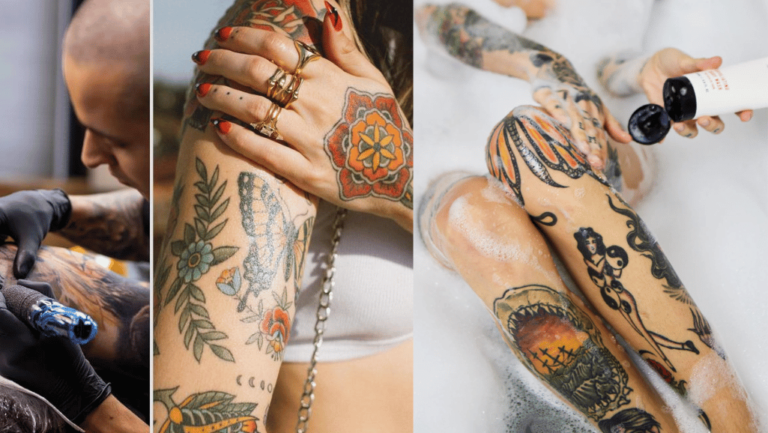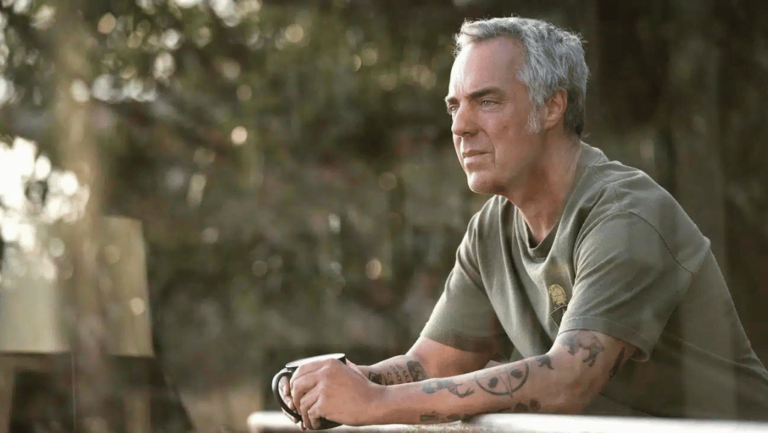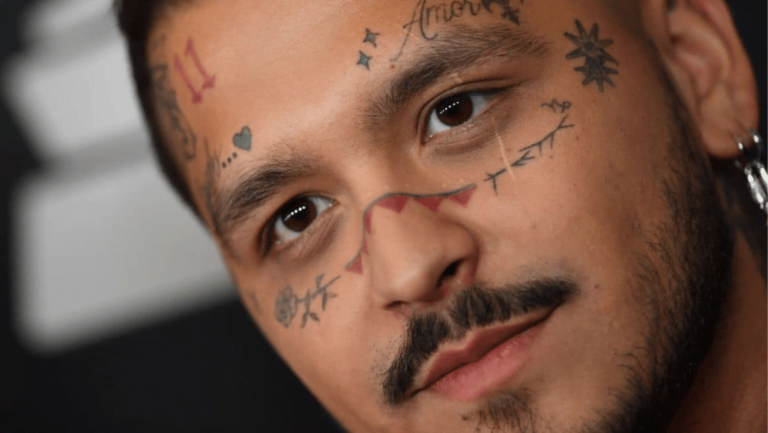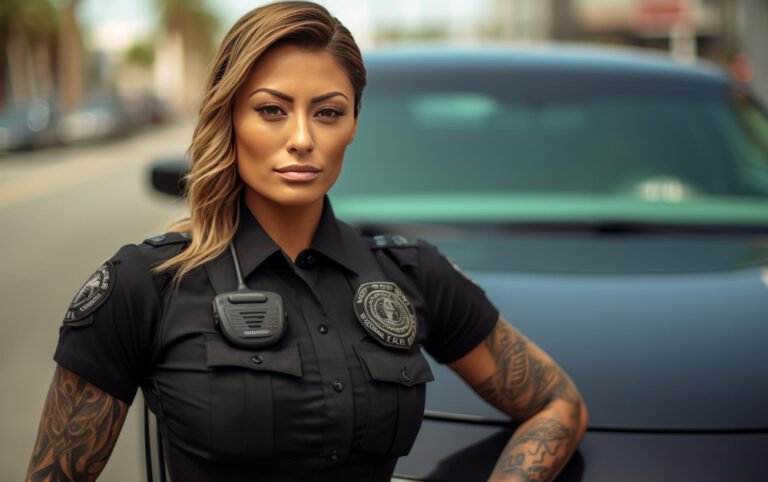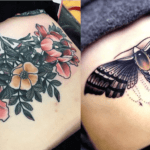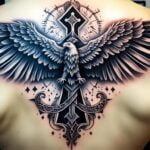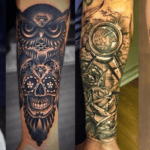Tattoos are a lasting way to show your style, done by putting ink under the skin with needles. Choices like henna only last for a while, unlike tattoos. More than half of young Americans have tattoos, planning them out as part of their look. But, when it comes to moms who are either expecting or have a new baby, safety is a big concern.
People worry about the dangers of tattoos while breastfeeding. These worries include getting sick from infections or the tattoo ink getting into the milk. Infections can be from different sources, like tetanus, hepatitis, and HIV. Also, using red ink can lead to skin allergies. Because of these serious concerns, doctors often tell mothers not to get tattoos when they are breastfeeding. This advice is to keep both the mom and baby safe and healthy.
Key Takeaways
- Over 50% of Americans under 40 have tattoos.
- Local and systemic infections are common side effects of tattoos.
- Red inks are the most common ink type to cause allergic reactions.
- Systemic infections from tattoos can result in tetanus, hepatitis, and HIV.
- Medical experts often advise against getting tattoos while breastfeeding.
Introduction to Tattoos and Breastfeeding
Tattoos are an ancient form of self-expression that has lasted through time. They come in many forms, from intricate designs to bold symbols. The process involves a needle filled with ink, poking the skin gently to leave a mark. This practice uses inks that can contain harmful substances, despite their popularity, particularly among the young.
Definition and History of Tattoos
The practice of tattooing has been around for thousands of years. Throughout history, tattoos have had various meanings. They acted as signs of culture, individualism, and sometimes protection or status. In the modern era, tattoos represent personal stories, group affiliations, or sometimes just a love of art. With more people considering getting tattoos while breastfeeding, it is important to consider the health risks.
Importance of Understanding Safety During Breastfeeding
Tattoos are becoming increasingly common, especially among young people. This makes it crucial to think about safety, especially for those who are breastfeeding. There are several risks to be aware of, including allergies and serious infections. When getting a tattoo, it’s important to choose a clean and reputable place. Also, it’s crucial to keep the tattooed area clean while it heals.
The Popularity of Tattoos Among Younger Adults
The allure of tattoos is strong among young adults in the U.S. This is particularly important for new mothers. Certain risks are involved with getting a tattoo while breastfeeding. These include potential harm from the ink and the possible distortion of a tattoo on the breast. It’s generally suggested to wait until after breastfeeding to consider a tattoo removal.
The decision to get a tattoo while breastfeeding requires careful thought. Both current and future mothers should consider the risks involved. It’s important to put the health and safety of the baby first.
Learn more about the tattoo process and considerations while breastfeedingCan You Breastfeed if You Have Tattoos?
Many moms wonder if they can breastfeed safely with tattoos. It’s key to know the *impact of tattoos on breastfeeding* for a well-thought decision.
Impact of Existing Tattoos
Tattoos you already have usually won’t affect breastfeeding. This is because the ink stays below the skin’s surface. Even though more than 40% of moms with tattoos got them after their first baby, only about 10% had breastfeeding issues they blamed on tattoos.
It’s also worth noting that while tattoos shouldn’t affect breast milk, some get criticized for having them while nursing. This was reported by about 30% of mothers with tattoos.
Issues of Tattoo Placement
Where your tattoos are placed matters. Areas like the breasts might lead to problems like irritation or infection, which can indirectly impact breastfeeding. Some 5% of women get tattoos while pregnant or nursing, showing timing and place are key.
Also, about 15% more challenges in breastfeeding are seen in women with tattoos compared to those without. This suggests an intricate relationship between tattoos and nursing mechanics.
Safety Measures to Consider
Applying proper *safety measures for tattoos with infants* is vital during breastfeeding. It’s important to keep all tools clean to avoid infections. Despite 60% of tattooed moms thinking about removing their ink, only 20% take action, showing worries about safety and looks.
To be safe, choose a trusted tattoo artist who follows strict hygiene. This care reduces health risks for the mom and baby when getting new tattoos.
| Statistic | Percentage |
|---|---|
| Women tattooed after first childbirth | Over 40% |
| Women received tattoos while pregnant/breastfeeding | Approximately 5% |
| Consider tattoo removal | 60% |
| Proceed with tattoo removal | 20% |
| Issues with breastfeeding | 10% |
| Increase in breastfeeding difficulties (tattooed vs. non-tattooed) | 15% |
| Negative comments about tattoos while breastfeeding | 30% |
For in-depth details, look into sources like La Leche League International. They provide valuable information on the *impact of tattoos on breastfeeding*.
Risks of Tattoos During Breastfeeding
Deciding to get a tattoo while breastfeeding involves thinking about several risks. It’s essential to know these dangers. This helps mothers make smart decisions for their health and their baby’s safety.
Potential Infections
Infections, like local ones at the tattoo site, are quite common. These can make the area red, swollen, and painful. Besides, there’s a risk of serious diseases like tetanus, hepatitis, and HIV from tattoos. Antibiotics help with local infections, but a doctor’s visit is necessary. Some medicines might not be safe for breastfeeding moms.
Potential infections are a significant concern for moms getting tattoos while breastfeeding.
Allergic Reactions to Ink
Among tattoo inks, red inks can trigger allergic reactions. Symptoms include itching, rashes, and swelling. These reactions can get worse, making things tricky if treatment isn’t safe for your baby.
Blood-Borne Infections
Getting a tattoo from non-sterilized equipment can cause blood infections. These include MRSA, hepatitis, and HIV. Choosing a well-known artist who cleans their tools well is crucial.
Though tattoo ink entering breast milk is very rare, the concern remains. Some worry the ink might break down over time and get into the milk.
| Tattoo Risks | Implications During Breastfeeding |
|---|---|
| Local Infections | Redness, swelling, and pain; treated with antibiotics |
| Systemic Infections | Tetanus, hepatitis, HIV; severe implications and treatments may not be breastfeeding-safe |
| Allergic Reactions | Itching, rashes; management complicated by breastfeeding-safe medications |
| Blood-Borne Infections | MRSA, hepatitis, HIV; severe implications if unsterilized equipment is used |
It’s important to fully think over the risks of tattoos while breastfeeding. Checking that the tattoo place is very clean helps lower some risks. But, being informed and careful is always the best course.
Expert Opinions on Tattooing While Breastfeeding
Getting tattoos while breastfeeding is a topic debated by many health experts. It’s crucial for nursing mothers to understand the risks tattoos might pose. Seeking medical advice before making a decision is very important.
Medical Organizations and Their Stances
No major health group says you can’t get a tattoo while nursing. Still, groups like the Journal of Midwifery and Women’s Health warn against it. They say it’s best to avoid tattoos when nursing to be safe.
Tattoos carry some health risks, such as allergic reactions or infections. These can be serious. Most health professionals advise looking into these risks very carefully. Thinking twice before getting a tattoo is smart.
Opinions of Individual Health Professionals
Doctors, like Dr. Madden, often say it’s safer not to get tattoos while breastfeeding. There isn’t enough evidence to prove if it’s safe or not. They stress seeking medical advice first.
Tattoo shops sometimes ask breastfeeding moms to sign waivers about risks. This is a common practice. It suggests that many health experts agree on being careful.
Maintaining the health of the mother and baby is very important. Health professionals recommend talking to a doctor about getting a tattoo. Waiting until you’re no longer breastfeeding might be the best choice.
Health Risks of Tattoos for Nursing Mothers
Getting a tattoo while breastfeeding can lead to worries about health impacts. It’s important for nursing moms to know the risks. Even though many people, especially those under 40, have tattoos, mothers who nurse need to be extra careful.
The Concern of Ink Transfer into Breast Milk
Many worry that tattoo ink might get into breast milk. Yet, there’s no proof this happens. The ink is deep in the skin and doesn’t easily get into milk. But, we still need to study more about this.
Systemic Infections
Getting a tattoo can lead to serious whole-body infections. If tattoo shops aren’t clean, you could get very sick. Diseases like tetanus, hepatitis, and HIV are all possible. So is a difficult-to-treat infection called MRSA. These sicknesses could then pass to a baby. It’s key to only go to clean shops for your safety and your baby’s.
Localized Infections
Less critical infections from tattoos are also a risk. Poor tattoo care can lead to these. Red ink is often the issue, causing mild to very bad skin reactions. Following a careful tattoo clean-up and avoiding dirty areas can help a lot.
Here’s some advice to keep away infections:
| Risk Factor | Preventative Measure |
|---|---|
| Systemic Infections | Ensure sterile equipment and receive tattoos from reputable establishments. |
| Localized Infections | Follow strict aftercare routines; clean tattoo with mild soap and water regularly. |
| Allergic Reactions | Avoid inks prone to causing allergies, such as red inks, unless tested for allergies. |
Learning about the health risks of tattoos for nursing mothers and how to avoid them is very important. By focusing on cleanliness and picking a good tattoo artist, you can lower the risks. Concerns about ink and breastfeeding show us the need for good hygiene and care after getting a tattoo.
Precautions for Tattooing While Breastfeeding
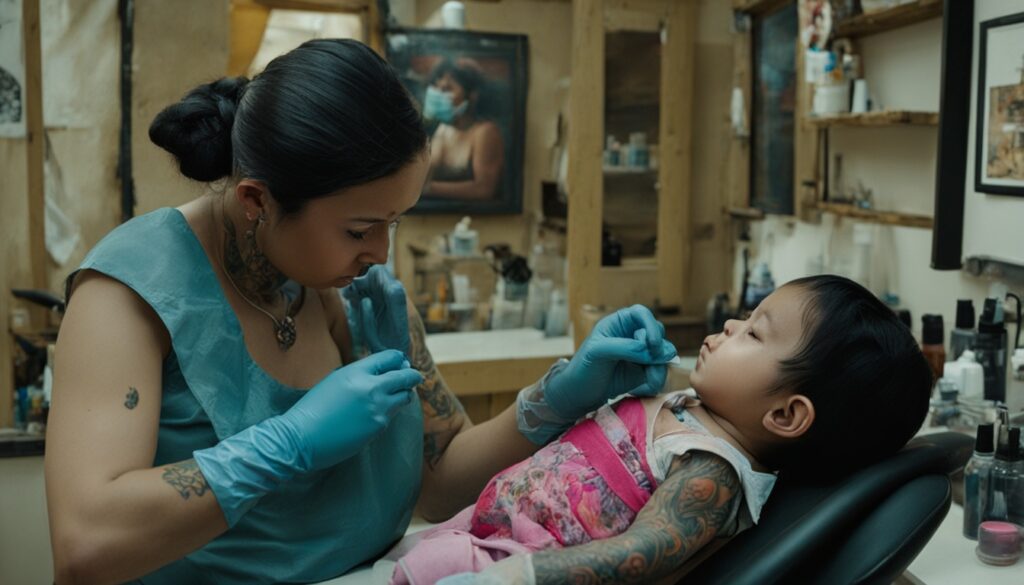
If you’re thinking about getting a tattoo while breastfeeding, you need to be careful. It’s important to keep both you and your baby safe. Tattoos are cool, but you should follow some steps to avoid risks.
Choosing the Right Tattoo Artist
It’s key to pick a licensed tattoo artist. A good artist works in a clean, safe place. Look for someone known for using fresh needles and keeping things sterile.
Ensuring Sterile Tattooing Practices
U.S. FDA doesn’t check tattoo inks, which can be risky. Make sure your artist uses clean, disposable tools. This step helps prevent infections that might harm you or your baby.
Aftercare and Managing Infections
Taking care of your tattoo is a big deal, especially if you’re breastfeeding. Keep it clean and avoid the sun. Watching for infection is crucial. If you get an infection, speak to your doctor about safe medicines.
According to the Human Milk Banking Association of America, wait eight days before donating breast milk after a tattoo. This wait is an extra safety measure.
Tattoo Healing Process During Breastfeeding
The healing process of a tattoo is complex, especially for moms who are nursing. It’s important to take care of your tattoo properly early on to avoid possible issues. Lets look at how tattoos heal, what you need to do, and how to spot an infection.
Stages of Tattoo Healing
Tattoo healing happens in stages:
- Initial Stage: In the first week, you might see swelling, redness, and plasma oozing.
- Intermediate Stage: The second and third weeks bring scabbing and itching as new skin grows.
- Final Stage: After four to six weeks, it looks healed. But, the deeper skin layers are still healing.
Aftercare for Nursing Mothers
Aftercare and avoiding infections are crucial. Here are steps you should take:
- Keep your tattoo clean by gently washing it with mild soap.
- Avoid sunlight and things that could irritate your tattoo.
- Use the right ointment to moisturize your skin.
Mothers who are nursing should follow these steps closely. With infection being a common tattoo issue, these steps are key for a smooth healing process.
Signs of Infection to Watch For
It’s important to watch for signs of infection:
- If redness, swelling, or pain gets worse over time.
- If it starts to hurt more or feels tender.
- If you notice pus or a bad smell.
- Or, if you get a fever or chills.
Recognizing these signs early can stop serious issues. Moms need to be very careful because serious infections can lead to diseases like tetanus or hepatitis. Keep your tattoo clean and follow these steps closely to avoid infections.
It’s smart to consult with a doctor and check WebMD to learn more about the risks of tattoos when breastfeeding.
Expert Advice on Managing Tattoo Infections While Breastfeeding
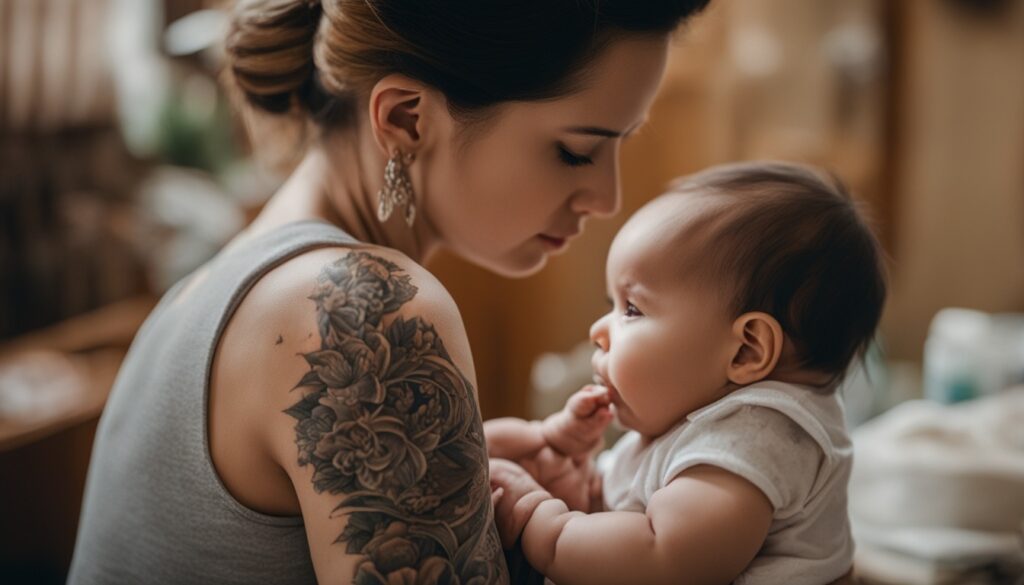
People need to be extra careful when dealing with tattoo infections and breastfeeding. Moms have to protect themselves and their babies. They should aim to avoid infections and know what to do if one happens after getting a tattoo.
Medications Safe for Breastfeeding Mothers
Choosing the right medication is key when you’re a new mom with a tattoo infection. Acetaminophen is safe and helps with pain. Before taking anything else, it’s a must to check with a doctor to keep the baby safe.
Be careful with strong antiseptics and antibiotics. For tattoos, use gentle cleaners like hydrogen peroxide. Avoid strong antibiotics unless the doctor says to use them.
When to Consult a Doctor
If your tattoo gets worse – more red, swollen, or painful – see a doctor right away. After giving birth, your body might be less ready to fight infections. A quick checkup can prevent bad things from happening.
Also, don’t wait if you get a fever with chills. This could be serious and needs immediate medical care. Always follow your doctor’s advice closely when healing from a tattoo and nursing a baby.
Preventative Measures
Preventing infection is the best strategy. Clean and protect your tattoo. Don’t mess with it and keep things as sanitary as possible. Try to get help from others since you might be very tired.
When picking a tattoo artist, make sure they are top-notch in cleanliness. Be aware, many doctors suggest waiting if you want a tattoo now. If you do get one, choose a location that is easy to keep clean when taking care of your baby.
| Precaution | Description | Advice |
|---|---|---|
| Licensed Tattoo Artist | Ensure the tattoo artist is licensed and follows sterile procedures. | Reduces risk of infection from unsterilized equipment. |
| Proper Aftercare | Clean tattoo with mild soap and water, avoid picking at scabs. | Prevents local infections and promotes healing. |
| Safe Medications | Use medications that are safe for breastfeeding, such as acetaminophen. | Manages pain and prevents infection without harming the baby. |
| Consult a Doctor | Seek medical advice if signs of infection appear. | Ensures timely intervention and appropriate treatment. |
Myths and Misconceptions About Tattoos and Breastfeeding
Talk of tattoos and breastfeeding often starts many false beliefs. These myths cause worries that are not needed. It’s important to clear up what’s true and what’s not, so we can make smart choices.
Common Misconceptions
People sometimes think tattoos can hurt babies who drink breast milk. They also fear that the ink might mix with the milk. And there’s the idea that moms with tattoos can’t donate their milk. But, these ideas don’t have real proof but they are still prevalent.
Debunking Popular Myths
A big myth is that the ink from tattoos can get into the milk. Yet, it’s safe to breastfeed even with tattoos. The Human Milk Banking Association of America says it’s okay to donate milk if a clean, single-use needle was used in the tattoo.
- Existing tattoos do not affect the milk supply or harm the baby.
- Breastfeeding mothers with tattoos can still donate breast milk.
Facts About Tattoos and Breastfeeding
When thinking about a tattoo while breastfeeding, the main worries are allergic reactions and infections. Possible diseases like HIV or hepatitis C might be a concern too. It’s essential to pick a safe, clean tattoo studio and talk about any health issues with your doctor.
There isn’t much info on if tattoo removal might affect the milk. But, breastfeeding can change how tattoos look for a bit. This is something to think about.
Many aren’t sure if you should get a tattoo while breastfeeding. People are mostly worried about what might happen, not what really does. Knowing the myths and facts about tattoos while nursing helps. It lets mothers make choices based on truth.
Future Research Directions on Tattoos and Breastfeeding Safety

Tattoos are more popular than ever. People want to know if they’re safe to have while breastfeeding. We have some guidelines, but we really need more detailed research.
The Need for More Scientific Data
Right now, we lack a lot of scientific facts about tattoos and breastfeeding safety, especially in the long run. This information gap is a big concern for moms like Maria who breastfed for 16 months. Also, Fiona is worried about infection risks. They highlight the urgent need for solid, well-designed studies.
Future research should look into how tattoo ink may move through the body. We need to understand if ink can change milk’s composition or impact babies in any way.
Potential Research Topics
There are a few key research areas we should explore further:
- Looking at what tattoo ink components do to breast milk over time.
- Figuring out if and how non-toxic tattooing is safe during breastfeeding.
- Learning about how our bodies get rid of tattoo ink particles.
- Checking for any health issues in infants whose mothers got tattoos while breastfeeding.
It’s also important to study new tattoo technologies, like non-toxic tattooing. These studies could show safer options for moms who breastfeed. By learning more, we can make better safety guidelines. This helps moms feel more sure when making choices for themselves and their babies.
Conclusion
It’s crucial for nursing moms to be cautious about new tattoos. While old tattoos don’t often cause trouble with breastfeeding, new ones should be thought about carefully. Knowing the health risks of getting tattooed while nursing helps moms decide wisely. This choice focuses on both their health and their baby’s well-being.
Tattoo ink is usually too big to get into breast milk, which is a bit of good news. Still, there are some dangers. These include allergic reactions to certain ink colors, such as red, and the chance of infections if the tattooing isn’t done in a clean way. It’s key to make sure the tattoo parlor is clean and to follow all aftercare advice. Doing this lowers the risk of infection, keeping nursing safe. You can learn more from this helpful resource.
If a nursing mom wants to get something, she can try temporary options like Henna or Symbolic Jewelry. This might be a better choice. If there are worries or issues, talking to a health care professional is important. They can give advice that’s just right for her health situation. This way, a mom can find the best balance between expressing herself and taking care of her baby. Always follow safety tips and keep an eye on new studies before making up your mind.
FAQ
What are the safety concerns with getting a tattoo during breastfeeding?
Can I breastfeed if I already have tattoos?
What should I consider before getting a tattoo while breastfeeding?
Are there any specific precautions that breastfeeding mothers should take when getting a tattoo?
What are the signs of a tattoo infection, and how can it affect breastfeeding?
Are there safe medications for treating tattoo infections during breastfeeding?
Can tattoo ink transfer into breast milk and affect my baby?
What expert opinions exist on tattooing while breastfeeding?
Are there any myths about tattoos and breastfeeding?
What research is needed on the safety of tattoos during breastfeeding?
Forhad
Forhad's writing is not just about the artistry of tattoos or the latest trends in the industry; it's an exploration of the deep-rooted connections people have with their tattoos, reflecting personal narratives, cultural histories, and moments of transformation. Through a mix of in-depth features, personal narratives, and insightful analyses, he sheds light on the multifaceted nature of tattooing, revealing the emotional and cultural layers that lie beneath the surface.

